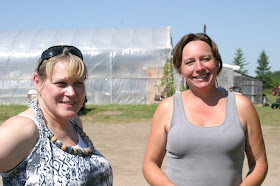Today I present Black Welsh lamb from Val at Newland's Ranch. I didn't buy it at the Market because they butchered a couple of months ago but I still consider it seasonal. My specialty salts were purchased in Victoria and contain the only Canadian sea salt available. Check out Sea to Sky Seasonings. Baby beets and potatoes are at the Market, rosemary and sorrel are in my garden.
I do say that there is nothing more satisfying than a nicely prepared meal with quality ingredients. Be creative and serve up some fresh food tonight. This meal has been made 'stove top' so I did not have to turn on the oven on such a hot day. I enjoyed a flute of La Chasse du Pape Blanc de Blancs bubbly. In the winter I would definitely have a robust red, but it is a hot day and champagne compliments everything I can think of. This is almost champagne.
My dinner tonight is....
Black Welsh Lamb Loin Chops finished with Commercial Drive Salt
Pan Roasted Rosemary Baby Potatoes with Toasted Pinenuts
Roasted Baby Beets and Chevre in an Orange Olive Oil Vinaigrette with Davie Street Salt on a bed of Garden Sorrel
To make the pan roasted baby potatoes, wash and quarter baby potatoes. Place cut side down in a preheated pan with a little olive oil. Turn the potatoes to brown on all sides. Snip fresh rosemary over and serve with toasted pine nuts. Toast pine nuts in a dry pan until lightly browned.
The beets can be tossed in a little olive oil and baked in the oven until tender. Oven roasting brings out the sweetness and robust flavour. You can also bake them on a barbecue for a wonderful smoky flavour. Orange juice and olive oil are combined with freshly cracked black pepper and sea salt for a simple dressing. Top with soft chevre or goat cheese.
For the lamb. lightly heat a pan with a little olive oil. Place the lamb in the hot pan and turn when browned. Lower the heat to cook until the desired doneness. Finish with freshly ground black pepper and sea salt.





















